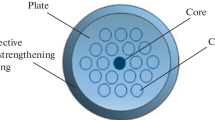Abstract
The high-speed glass fiber drawing in a silica-based optical fiber mass manufacturing system is numerically modeled and simulated on draw furnace model to systematically examine how the use of highly expensive helium in purge gas supply greatly improves the process stability and purging of contamination particles. The numerical results found the undesirable purge gas flow phenomena such as large buoyancy driven flow recirculations and periodic or quasi-chaotic flow patterns around the preform neck-down formation, when the purge gas is made of argon only. The effects of helium contents and flowrates in purge gas supply of argon/helium mixture are extensively investigated on neck-down formation and purge gas flow patterns. In contrast, it is shown that the helium usage effectively eliminates the flow recirculation and flow instability. The optimization of purge gas supply condition is also discussed in an effort to reduce helium consumption.
Similar content being viewed by others
References
K. Richardson, D. Krol and K. Hirao, Glasses for photonics applications, International Journal of Applied Glass Science, 1(1) (2010) 74–86.
U. C. Paek, Free drawing and polymer coating of silica glass optical fibers, Journal of Heat Transfer, 121(4) (1999) 1–15.
Y. Jaluria, Thermal issues in materials processing, Journal of Heat Transfer, 135(6) (2013) 061701.
K. Kim, H. S. Kwak, S. H. Park and Y. S. Lee, Theoretical prediction on double-layer coating in wet-on-wet optical fiber coating process, Journal of Coatings Technology and Research, 8(1) (2011) 35–44.
S. T. Anderson, Economics, helium, and the U.S. federal helium reserve: summary and outlook, Natural Resources Research, 27(4) (2017) 455–477.
B. A. Glowacki, W. J. Nuttall and R. H. Clarke, Beyond the helium conundrum, IEEE Transactions on Applied Superconductivity, 23(3) (2013) 0500113.
S. H. K. Lee and Y. Jaluria, Simulation of the transport processes in the neck-down region of a furnace drawn optical fiber, International Journal of Heat and Mass Transfer, 40(4) (1997) 843–856.
X. Cheng and Y. Jaluria, Optimization of a thermal manufacturing process: drawing of optical fibers, International Journal of Heat and Mass Transfer, 48(17) (2005) 3560–3573.
K.-M. Lee, Z. Wei, Z. Zhou and S.-P. Hong, Computational thermal models for design of a modern fiber draw process, IEEE Transactions on Automation Science and Engineering, 3(1) (2006) 108–118.
A. Mawardi and R. Pitchumani, Optical fiber drawing process model using an analytical neck-down profile, IEEE Photonics Journal, 2(4) (2010) 620–629.
Y. K. Kim, J. S. Choi, H. S. Kwak and K. Kim, Numerical modeling and analysis of glass fiber drawing process from large sized silica perform, Journal of Thermal Science and Technology, 12(2) (2017) JTST0030.
Z. Yin and Y. Jaluria, Thermal transport and flow in high-speed optical fiber drawing, Journal of Heat Transfer, 120(4) (1998) 916–930.
K. Kim, H. S. Kwak and D. Kim, The role of helium/argon gas flow in a glass fiber drawing furnace, Computational Thermal Sciences, 4(3) (2012) 263–270.
G. G. Carandang and K. Kim, Numerical investigation on He and Ar gas convective cooling for optical fiber glass drawing at short draw towers, Journal of Mechanical Science and Technology, 33(12) (2019) 5653–5658.
H. M. Reeve and A. M. Mescher, Effect of unsteady natural convection on the diameter of drawn polymer optical fiber, Optics Express, 11(15) (2003) 1770–1779.
S. Sondur and A. M. Mescher, Investigation on the stability of natural convection in an annular cavity with non-isothermal walls, Experimental Thermal and Fluid Science, 115 (2020) 110053.
H. M. Reeve, A. M. Mescher and A. F. Emery, Investigation of steady-state drawing force and heat transfer in polymer optical fiber manufacturing, Journal of Heat Transfer, 126(2) (2004) 236–243.
R. H. Doremus, Viscosity of silica, Journal of Applied Physics, 92(12) (2002) 7619–7629.
G. Urbain, Y. Bottinga and P. Richet, Viscosity of liquid silica, silicates and alumino-silicates, Geochimica et Cosmochimica Acta, 46(6) (1982) 1061–1072.
Acknowledgments
This research was supported by the National Research Foundation of Korea (NRF) grant funded by the Korean Government (MSIT) (NRF-2022R1F1A1064925).
Author information
Authors and Affiliations
Corresponding author
Additional information
Euntaek Lee received the B.S. degree from Chung-Ang University in 2004, M.S. degree from Korea Advanced Institute of Science and Technology in 2007 and Ph.D. degree from University of California Los Angeles in 2013, all in the academic area of mechanical engineering. He is currently the Associate Professor of Department of Mechanical System Engineering at Kumoh National Institute of Technology in Gumi, Korea. His research interests include the heat transfer and fluid flow analysis.
Joonsu Kim is pursuing the B.S. degree in mechanical system engineering from Kumoh National Institute of Technology, Gumi, Korea. Currently, he is the Production and Logistics manager in Valeo Pyeong Hwa Automotive Components (VPHC) in Daegu, Korea. His research interests are computational fluid dynamics, fluids and heat transfer.
Gia Ginelle Carandang received a B.S. degree in mechatronics from the Technological University of the Philippines, Manila, in 2015, and a B.S. and M.S. degrees in mechanical system engineering from Kumoh National Institute of Technology, Gumi, Korea, in 2019. Currently, she is a Ph.D. degree student in mechanical systems engineering at Tokyo Metropolitan University, Japan. Her research interests are computational modeling, fluids, and thermal engineering for mechanical systems.
Kyoung** Kim received the B.S. and M.S. degrees from Seoul National University in 1988 and 1990, respectively, and the Ph.D. degree from The University of Texas at Austin in 1998, all in the academic area of mechanical engineering. He is currently the Professor of Department of Mechanical System Engineering at Kumoh National Institute of Technology in Gumi, Korea. His research interests include the numerical modeling of heat transfer phenomena in materials processing and thermal plasma applications such as pyrotechnic explosive initiators.
Rights and permissions
About this article
Cite this article
Lee, E., Kim, J., Carandang, G.G. et al. Analysis of helium/argon purge gas flows in industrial scale glass fiber drawing system. J Mech Sci Technol (2024). https://doi.org/10.1007/s12206-024-2103-8
Received:
Revised:
Accepted:
Published:
DOI: https://doi.org/10.1007/s12206-024-2103-8



